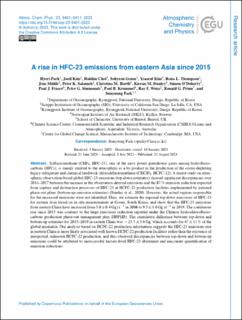| dc.contributor.author | Park, Hyeri | |
| dc.contributor.author | Kim, Jooil | |
| dc.contributor.author | Choi, Haklim | |
| dc.contributor.author | Geum, Sohyeon | |
| dc.contributor.author | Kim, Yeaseul | |
| dc.contributor.author | Thompson, Rona Louise | |
| dc.contributor.author | Mühle, Jens | |
| dc.contributor.author | Salameh, Peter K. | |
| dc.contributor.author | Harth, Christina M. | |
| dc.contributor.author | Stanley, Kieran M. | |
| dc.contributor.author | O'Doherty, Simon | |
| dc.contributor.author | Fraser, Paul J. | |
| dc.contributor.author | Simmonds, Peter G. | |
| dc.contributor.author | Krummel, Paul B. | |
| dc.contributor.author | Weiss, Ray F. | |
| dc.contributor.author | Prinn, Ronald G. | |
| dc.contributor.author | Park, Sunyoung | |
| dc.date.accessioned | 2023-12-04T07:58:19Z | |
| dc.date.available | 2023-12-04T07:58:19Z | |
| dc.date.created | 2023-10-25T12:40:48Z | |
| dc.date.issued | 2023 | |
| dc.identifier.citation | Atmospheric Chemistry and Physics (ACP). 2023, 23 (16), 9401-9411. | en_US |
| dc.identifier.issn | 1680-7316 | |
| dc.identifier.uri | https://hdl.handle.net/11250/3105698 | |
| dc.description.abstract | Trifluoromethane (CHF3, HFC-23), one of the most potent greenhouse gases among hydrofluorocarbons (HFCs), is mainly emitted to the atmosphere as a by-product in the production of the ozone-depleting legacy refrigerant and chemical feedstock chlorodifluoromethane (CHClF2, HCFC-22). A recent study on atmospheric observation-based global HFC-23 emissions (top-down estimates) showed significant discrepancies over 2014–2017 between the increase in the observation-derived emissions and the 87 % emission reduction expected from capture and destruction processes of HFC-23 at HCFC-22 production facilities implemented by national phase-out plans (bottom-up emission estimates) (Stanley et al., 2020). However, the actual regions responsible for the increased emissions were not identified. Here, we estimate the regional top-down emissions of HFC-23 for eastern Asia based on in situ measurements at Gosan, South Korea, and show that the HFC-23 emissions from eastern China have increased from 5.0±0.4 Gg yr−1 in 2008 to 9.5±1.0 Gg yr−1 in 2019. The continuous rise since 2015 was contrary to the large emissions reduction reported under the Chinese hydrochlorofluorocarbons production phase-out management plan (HPPMP). The cumulative difference between top-down and bottom-up estimates for 2015–2019 in eastern China was Gg, which accounts for 47±11 % of the global mismatch. Our analysis based on HCFC-22 production information suggests the HFC-23 emissions rise in eastern China is more likely associated with known HCFC-22 production facilities rather than the existence of unreported, unknown HCFC-22 production, and thus observed discrepancies between top-down and bottom-up emissions could be attributed to unsuccessful factory-level HFC-23 abatement and inaccurate quantification of emission reductions. | en_US |
| dc.language.iso | eng | en_US |
| dc.rights | Navngivelse 4.0 Internasjonal | * |
| dc.rights.uri | http://creativecommons.org/licenses/by/4.0/deed.no | * |
| dc.title | A rise in HFC-23 emissions from eastern Asia since 2015 | en_US |
| dc.title.alternative | A rise in HFC-23 emissions from eastern Asia since 2015 | en_US |
| dc.type | Peer reviewed | en_US |
| dc.type | Journal article | en_US |
| dc.description.version | publishedVersion | en_US |
| dc.rights.holder | © Author(s) 2023. | en_US |
| dc.source.pagenumber | 9401-9411 | en_US |
| dc.source.volume | 23 | en_US |
| dc.source.journal | Atmospheric Chemistry and Physics (ACP) | en_US |
| dc.source.issue | 16 | en_US |
| dc.identifier.doi | 10.5194/acp-23-9401-2023 | |
| dc.identifier.cristin | 2188338 | |
| cristin.ispublished | true | |
| cristin.fulltext | original | |
| cristin.qualitycode | 2 | |

